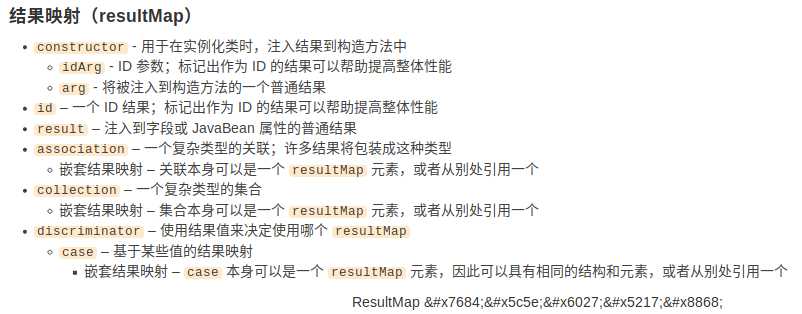双数据源实体类映射oracle字段有的字段无法映射
Posted
tags:
篇首语:本文由小常识网(cha138.com)小编为大家整理,主要介绍了双数据源实体类映射oracle字段有的字段无法映射相关的知识,希望对你有一定的参考价值。
参考技术A 数据没有处理好所谓实体类与数据库之间的映射,其实就是在java中创建一个类,用来存放数据库里的某一张表。
但是,如果只是在纯粹的桌面端与web端开发中,没有使用到框架的化,其实字段与属性之间的映射要求并没有那么严格。但是,使用MyBatis框架之后,对于字段与属性之间的关系,是十分严格的。
_ 当实体类与数据库存在部分字段无法正确映射时,可以使用ResultMap作为中间组件,将数据库的字段映射给实体类
mybatis从入门到精通 结果映射
mybatis从入门到精通(三) 结果映射
一丶什么是结果映射
结果映射是用于将数据库表字段和实体类中的属性名映射起来, 即究竟是哪个字段名与属性名对应. 映射之后, 即可通过mybatis将从数据库查询的结果转换成对应的实体类对象类型, 除去了人工转换的麻烦.
二丶自动映射
所谓的自动映射, 即是默认java实体类的属性名是驼峰式, 而数据库表字段名是以下划线分隔, 如 属性名userName 与 表字段user_name相对应, 如果是这种简单通用的规则, 即可通过配置mybatis, 使得mybatis自动映射.
1) 在mybatis-config.xml中配置开启下划线和驼峰式的自动映射
settings>
<!-- 是否开启下划线和驼峰式的自动转换, http://www.mybatis.org/mybatis-3/zh/sqlmap-xml.html#Auto-mapping -->
<setting name="mapUnderscoreToCamelCase" value="true"/>
</settings>
2) 在userReulstMapper.xml中配置对应的<ResultMap>, 只需配置id即可, 用于指定唯一标识, 其他映射由mybatis自动处理
<!-- 使用下划线和驼峰式的自动映射(autoMapping)转换, http://www.mybatis.org/mybatis-3/zh/sqlmap-xml.html#Auto-mapping, 需要在mybatis-config.xml配置文件中配置mapUnderscoreToCamelCase属性为true, 可在resultMap中设置autoMapping来控制是否开启自动映射, 默认为true --> <resultMap id="UserAutoResultMap" type="com.ttx.example.pojo.UserResult" autoMapping="true"> <id column="user_id"/> <!-- 标识主键--> </resultMap>
3) 写入mapper查询方法
UserResultMapper.java
List<UserResult> selectUserByUserNameLike(@Param("userName") String userName);
UserResultMapper.xml
<select id="selectUserByUserNameLike" resultMap="UserAutoResultMap"> select * from user where user_name like #userName </select>
4) ResultMapTests.java 测试类方法
@Test public void autoMappingTest() // 测试结果集下划线和驼峰式的自动映射转换 List<UserResult> userResults=userResultMapper.selectUserByUserNameLike("t%"); Assert.assertTrue(userResults.size()>1);
二丶普通的单表结果映射
如下方的结果映射配置, type标明该配置会映射转换成对应的实体类型, 其中子元素<id/>用于标明该字段为唯一标识, 用于区分多条数据, <result/>则是普通的字段映射.
column属性用于指明表字段名, property用于指明对应实体类的属性名
<resultMap id="UserMap" type="com.ttx.example.entity.User">
<id column="user_id" property="userId"/>
<result column="user_name" property="userName"/>
<result column="age" property="age"/>
<result column="country" property="country"/>
</resultMap>

更多配置细节可以查看官方文档
三丶关联结果映射
一般的应用, 肯定不仅仅只是单表查询这么简单, 还会存在多表关联查询. 此时,查询的结果会很是复杂, 因此有了 关联<association/> 和 集合<collection/> 映射.
关联<association/> 和 集合<collection/> 作用类似, <collection/> 主要是多了ofType属性, 用于指明List<ofType>中的泛型类型, 但一般无须配置, mybatis会自动处理.
首先, 我们来看两张单表对应的实体类
public class UserResult private Integer userId; private String userName; private Integer age; private String country; public Integer getUserId() return userId; public void setUserId(Integer userId) this.userId = userId; public String getUserName() return userName; public void setUserName(String userName) this.userName = userName; public Integer getAge() return age; public void setAge(Integer age) this.age = age; public String getCountry() return country; public void setCountry(String country) this.country = country;
public class Email private Integer emailId; private Integer userId; private String emailAddress; private String password; public Integer getEmailId() return emailId; public void setEmailId(Integer emailId) this.emailId = emailId; public Integer getUserId() return userId; public void setUserId(Integer userId) this.userId = userId; public String getEmailAddress() return emailAddress; public void setEmailAddress(String emailAddress) this.emailAddress = emailAddress; public String getPassword() return password; public void setPassword(String password) this.password = password;
再看, 关联的pojo类
public class UserResultEmail private Integer userId; //需要使用userId标识 private UserResult userResult; private List<Email> emailList; // 关联 或者 集合 public Integer getUserId() return userId; public void setUserId(Integer userId) this.userId = userId; public UserResult getUserResult() return userResult; public void setUserResult(UserResult userResult) this.userResult = userResult; public List<Email> getEmailList() return emailList; public void setEmailList(List<Email> emailList) this.emailList = emailList;
2) 关联的映射配置如下:
<resultMap id="UserResultMap" type="com.ttx.example.pojo.UserResult">
<constructor></constructor> <!-- 用于引用构造参数, 可以省略掉 -->
<id column="user_id" property="userId"/> <!-- id 元素表示的结果将是对象的标识属性 -->
<result column="user_name" property="userName"/>
<result column="age" property="age"/>
<result column="country" property="country"/>
</resultMap>
<resultMap id="EmailMap" type="com.ttx.example.pojo.Email">
<id column="email_id" property="emailId"/> <!-- id 元素表示的结果将是对象的标识属性 -->
<result column="user_id" property="userId"/> <!-- 关联userResult的user_id属性-->
<result column="email_address" property="emailAddress"/>
<result column="password" property="password"/>
</resultMap>
<resultMap id="UserResultEmailMap" type="com.ttx.example.pojo.UserResultEmail">
<id column="user_id" property="userId"/> <!-- 由于是关联查询,会返回多个结果集, 需要指定唯一标识,去掉重复的值 -->
<association property="userResult" resultMap="UserResultMap"/>
<collection ofType="com.ttx.example.pojo.Email" column="email_id" property="emailList" resultMap="EmailMap"/> <!-- association,collection 关联查询, 用法差不多,区别在于ofType类型, 可以指定集合的具体类型 -->
</resultMap>
3) mapper对应的方法
UserResultMapper.java
UserResultEmail selectUserAndEmailByUserId(@Param("userId") int userId);
UserResultMapper.xml
<select id="selectUserAndEmailByUserId" resultMap="UserResultEmailMap" > select * from user u,email e where u.user_id=#userId and u.user_id=e.user_id </select>
4) 测试类方法
@Test public void associationTest() UserResultEmail userResultEmail=userResultMapper.selectUserAndEmailByUserId(1); Assert.assertTrue(userResultEmail!=null); System.out.println("userName: "+userResultEmail.getUserResult().getUserName()); System.out.println("emailSize: "+userResultEmail.getUserResult().getUserName());
学习资料:
以上是关于双数据源实体类映射oracle字段有的字段无法映射的主要内容,如果未能解决你的问题,请参考以下文章
abp 修改abp.zero的实体映射类,使生成的表和字段为大写状态
hibernate中使用annotation映射的时候,如何指定实体类中的某些字段不映射到数据库?